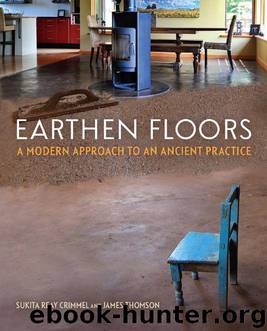Earthen Floors: A Modern Approach to an Ancient Practice by Reay Crimmel Sukita & Thomson James

Author:Reay Crimmel , Sukita & Thomson, James [Thomson, James]
Language: eng
Format: azw3, epub
ISBN: 9781550925616
Publisher: New Society Publishers
Published: 2014-04-20T16:00:00+00:00
Placement of vapor barrier in a wood-framed subfloor.
(CREDIT: JOHN HUTTON)
Drainage
Every on-grade subfloor should have a drainage layer. This is usually a layer of drainage rock, and in very wet soils may also include drainage pipes and/or a French drain. An important role of the drainage layer is to provide a capillary break, so that moisture in the ground cannot easily wick up into the upper layers of the subfloor. See Building a Compacted Gravel Subfloor appendix for more information, and consult a building professional if needed.
Vapor barrier
The ground contains moisture, which evaporates into water vapor. This vapor can migrate from the ground below up into the house; condense back into liquid water and cause increased humidity, mold growth and, in extreme cases, rot.
A vapor barrier is a waterproof membrane that blocks the movement of water vapor. Most building codes require the use of one in new construction; 6 mm black polyethylene plastic sheeting is the current standard for most situations. There are also paint-on barriers available for use on concrete slabs. Often a vapor barrier is added in conjunction with insulation. If working with a pre-existing subfloor that may not include a vapor barrier, consider adding one or test to see whether one is present.
Download
Earthen Floors: A Modern Approach to an Ancient Practice by Reay Crimmel Sukita & Thomson James.epub
This site does not store any files on its server. We only index and link to content provided by other sites. Please contact the content providers to delete copyright contents if any and email us, we'll remove relevant links or contents immediately.
Audition by Ryu Murakami(4099)
The Body: A Guide for Occupants by Bill Bryson(3802)
Adulting by Kelly Williams Brown(3671)
Housekeeping by Marilynne Robinson(3402)
Zero Waste Home by Bea Johnson(3292)
Be in a Treehouse by Pete Nelson(3214)
Seriously... I'm Kidding by Ellen DeGeneres(3100)
Better Homes and Gardens New Cookbook by Better Homes & Gardens(2954)
Barkskins by Annie Proulx(2880)
The Healing Self by Deepak Chopra(2796)
Hedgerow by John Wright(2777)
The Life-Changing Magic Of Tidying Up- The Japanese Art Of Decluttering And Organizing (v5.0) by Marie Kondo(2745)
Spark Joy by Marie Kondo(2677)
The Genius of Japanese Carpentry by Azby Brown(2609)
The Cellar by Natasha Preston(2595)
Work Clean by Dan Charnas(2562)
120 Days of Sodom by Marquis de Sade(2439)
A Monk's Guide to a Clean House and Mind by Shoukei Matsumoto(2405)
The Book of Numbers by Peter Bentley(2404)
